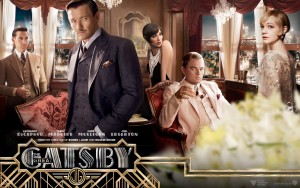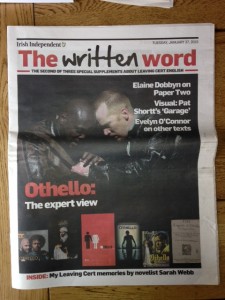This article first appeared in the Irish Independent Written Word supplement on Tuesday 27th January 2015.
If you are sitting Honours English for the Leaving Cert, you have to study Shakespeare but you don’t have to do it as your single text. You can include it as one of your comparatives and answer instead on one of the prescribed novels for the 60 mark single text question.
This years list (2015) of single texts to choose from if you’re doing honours English and are using Othello as part of your comparative are:
- Pride and Prejudice by Jane Austin
- Never Let Me Go by Kazuo Ishiguro
- The Great Gatsby by F. Scott Fitzgerald
- All My Sons by Arthur Miller
Because most of the country study Shakespeare for this section, you do have a certain psychological
advantage over your Bardic peers: any examiner will relish a break from the monotony of correcting the same content over and over again! However, when you see how easily students from other schools can get their hands on sample answers for every aspect of every character and theme in Othello, you may find yourself silently cursing your teacher. Fret not – your teacher knows exactly what they’re doing! No student ever did well by learning off sample answers prepared by other people. Nonetheless, it can be annoying to have few – if any – actual exam paper questions to work off, so here I’ll examine elements of character, theme and style it might be wise to revise.
Pride and Prejudice
CHARACTERS
- Elizabeth (Lizzy) Bennett – her strengths and weaknesses, your level of sympathy and/or admiration for her, her journey as a character and the extent to which she has changed over the course of the novel. Her search for her true self & whether or not Mr Darcy encourages or gets in the way of this quest.
- Mr Darcy – his strengths and weaknesses, his relationship with and influence over Lizzy.
- Mr Collins and Mr Wickham as foils to Mr Darcy and love interests for Lizzy.
- Jane, Mary, Kitty and Lydia and the representation of women they offer.
THEMES
- “Marriage as an obsession is the central theme of Pride and Prejudice”
- “Despite many setbacks, romantic love ultimately triumphs in Austen’s Pride and Prejudice”
- “Pride and Prejudice explores power and powerlessness in a world where women are second class citizens”
- “In Pride and Prejudice, all of Austen’s characters have trouble distinguishing between appearance and reality”
- “Social class concerns dominate the world created by Jane Austen in Pride and Prejudice”
STYLE
- “Austen uses many literary techniques in Pride and Prejudice to communicate the snobbery of the Regency Era”
- “Our view of events is limited by the use of first person narration, but expanded when necessary by Austen’s inclusion of letters as a literary device”
OPEN
- “Despite the happy ending, Pride and Prejudice offers a very negative view of the world the Bennett sisters inhabit”
Never Let Me Go
CHARACTERS:
- Kathy – her strengths and weaknesses, your level of sympathy and/or admiration for her, her journey as a character and the extent to which she has changed over the course of the novel. Her search for her true self & whether or not Mr Darcy encourages or gets in the way of this quest.
- Tommy – as above
- Ruth – as above
- Madame, Miss Emily, Miss Lucy – Examine the impact they have upon the central characters & the way they illustrate various themes.
THEMES:
- “The central theme of Never Let Me Go is the loss of innocence”
- “Never Let Me Go is a coming of age story which horrifies even as it enthralls”
- “Moral questions dominate Never Let Me Go but are never fully resolved”
- “Love and friendship are beacons of hope in the otherwise bleak novel Never Let Me Go”
- “The search for self, for one’s true identity, for what it means to be human, is both memorable and tragic in Ishiguro’s novel Never Let Me Go”
- “In Never Let Me Go, as the future becomes bleak, characters obsess over the past”
STYLE:
- “The true horror of this novel lies in the narrator’s calm acceptance of her nature & her fate”
- “Kathy is an unreliable narrator in, yet this only adds to the pathos of her plight”
OPEN:
- “Never Let Me Go is a timely novel which demands that we ask difficult questions about morality and the regulation of science”
The Great Gatsby
CHARACTERS:
- Nick Carraway – his role as narrator, his individual strengths and weaknesses, your level of sympathy and/or admiration for him, his journey as a character and the extent to which he changes over the course of the novel.
- Gatsby – his strengths and weaknesses, your level of sympathy and/or admiration for him, his journey as a character and the extent to which he changes over the course of the novel.
- Daisy – as above
- Main supporting characters – Tom, Jordan, George, Myrtle, Meyer Wolfshiem. Examine their impact upon the unfolding plot & the way they illustrate various themes.
THEMES:
- “The Great Gatsby powerfully illustrates both the allure and the folly of the American dream”
- “Idealism gives way entirely to despair in The Great Gatsby”
- “The Great Gatsby memorably evokes the social upheaval and decadence of the roaring twenties”
- “Obsessive love dominates The Great Gatsby, ultimately leading to ruination and despair”
- “The Great Gatsby at its heart is a novel about ego and ambition”
STYLE:
- “The title of “The Great Gatsby” is entirely ironic. Indeed irony, as a device, is used to devastating effect in the novel”
- “Poetic language and rich symbolism make The Great Gatsby a seductive and beautiful work of art”
OPEN:
- “The Great Gatsby offers an entirely depressing vision of human nature” Discuss
All My Sons
CHARACTERS:
- Joe – as a tragic hero; as an ‘everyman’; his strengths and weaknesses, your level of sympathy and/or admiration for him, his journey as a character and the extent to which he changes over the course of the play.
- Kate – her strengths and weaknesses, your level of sympathy and/or admiration for her, her journey as a character and the extent to which she changes over the course of the play.
- Chris – as above; plus his relationship with his parents, particularly his father.
- Ann – as above; plus her relationship with Chris, with her father and with Larry
- Minor characters: George, Larry, Frank, Jim – dramatic function in the play. Extent to which they illustrate various themes.
THEMES:
- “The central theme of Miller’s play ‘All My Sons’ is father-son relationships”
- “In ‘All My Sons’ secrets and lies shimmer beneath the ordinary surface of everyday life”
- “The destructive power of guilt is unleashed to devastating consequence in ‘All My Sons’”
- “The past haunts the present in ‘All My Sons’ and in many ways determines the future”
- “Justice and morality are central themes in Miller’s play”
STYLE:
- “In ‘All My Sons’, Miller plays with time to powerful dramatic effect”
- “Scenes of compelling drama in All My Sons prove that Miller is a master playwright”
OPEN:
- “The moral of Miller’s play is that we cannot escape the consequences of our actions”
Ordinary Level Single Texts
Students sitting the ordinary level paper have a wider choice of texts. They can choose any one of the following for their single text:
- Pride and Prejudice by Jane Austen
- Circle of Friends by Maeve Binchy
- The Great Gatsby by F. Scott Fitzgerald
- Never Let Me Go by Kazuo Ishiguro
- How Many Miles to Babylon? by Jennifer Johnston
- Home Before Night by Hugh Leonard
- All My Sons by Arthur Millar
Juno and the Paycock by Sean O’Casey - Othello by William Shakespeare








